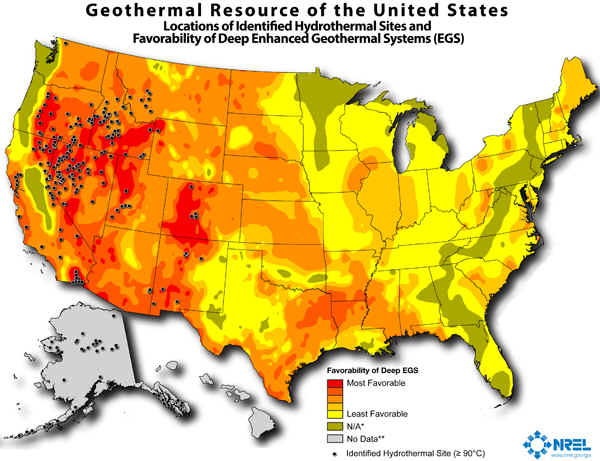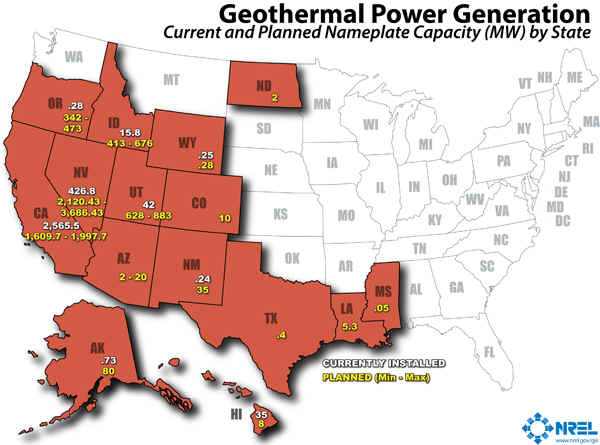|
U.S. has large
geothermal resources, but recent growth is slower than wind or solar

November 18,2011
EIA-Geothermal is one of the main renewable energy sources used to
generate U.S. electricity, even though its growth has not been as strong
as wind and solar over the last three years during a big push to increase
generation from renewables. Geothermal energy's greatest growth potential
is in the western states (see map above).
U.S. geothermal net
electricity generation totaled 10,898 million kilowatthours (kWh) during
the first eight months of 2011, up 10% from the same period in 2008,
according to the latest data from EIA's
Electric Power Monthly report. The data in the report reflects power
generation facilities of 1 megawatt or larger. Geothermal energy also
provides heating and cooling for three million Americans.
Compared to all generating
sources, geothermal produced just 0.4% of electricity from all sectors
nationally during the first eight months of this year. However, most
geothermal power plants are located in the western states (see map below)
with California producing the most electricity from geothermal, about 5%
of the state's total power generation.
Several factors have
influenced the growth of geothermal generating capacity:
- Technology
costs. New technology, referred to as enhanced geothermal
systems (EGS), which may allow greater use of geothermal resources in
other areas, is now in early-development. Current cost estimates for EGS
are generally higher than those for conventional geothermal plants and
other more mature renewable technologies like wind power.
- Location.
Geothermal plants can be very site-specific, and have generally been
limited to areas with accessible deposits of high temperature ground
water.
- Transmission
access. Lack of access to transmission lines, especially in
western states where the
geothermal resources are highest, limits growth.
- Completion lead
times. Completing a geothermal power generating project takes
four to eight years, longer than completion timelines for solar or wind.
- Risk.
Even in well-characterized resource areas, there is significant
exploration and production risk, which can result in high development
costs. Development is often undertaken incrementally at a site to
mitigate this risk and control costs
.
- To generate electricity
from geothermal resources, a well is usually drilled directly into an
underground geothermal reservoir of water that can be as hot at 700
degrees Fahrenheit (371 Celsius). The trapped steam is brought to the
surface to turn a turbine that produces electricity. Geothermal water is
also found on the surface as hot springs or geysers, according to the
Geothermal Energy Association (GEA).
Ground source heat
pumps move fluids through continuous pipeline loops that are buried
underground at depths where the temperature does not change much,
according to GEA. Heat picked up by the circulating fluid is delivered
to a home or commercial building through a traditional duct system.
During the summer, the pipeline loop pulls heat out of a building and
returns cooler fluid to cool the building.
The United States has
significant geothermal resources. Power generation from solar
facilities of at least 1 megawatt capacity was much smaller than
geothermal at 1,401 million kWh during the most recent January-August
period. However, EIA data shows that generation from solar facilities
over the last three years grew by 111%. Generation from distributed
solar facilities smaller than 1 megawatt has also risen rapidly in
recent years. Wind power increased even more at 121% to 79,186 million
kWh. Coal, natural gas, and nuclear remained the three biggest power
generation sources at about 43%, 24%, and 19%, respectively.
Credit:The U.S. Energy Information Administration (EIA)
|




